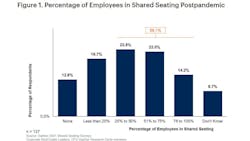Gartner: Shared seating will be the norm in post-pandemic office
A Gartner Inc. survey of corporate real estate (CRE) and finance professionals conducted in February 2021 showed that 59% expect shared office seating for at least a quarter of their employees who return to the office after the pandemic.
Technological as well as manual processes will ease the transition to shared seating, Gartner added.
“An increase in remote working will meaningfully change office space configurations, which will subsequently affect employees, finances and corporate real estate,” said Tammy Shoham, director Gartner’s finance practice. “The most obvious consequence is that firms will need less office space per employee. While it is difficult to accurately predict the long-term effects that will have on property markets, short-term impacts are already being felt.
“Many more office workers will need to get used to not having a desk of their own,” Shoham continued. “The space this frees can make room for things that are more useful to employees, such as meeting rooms, or collaboration and amenity spaces.”
Most of the 127 respondents to the survey expect that more than 25% of the workforce will be in shared seating in the next 1 to 2 years, and 36% anticipate that the majority of employees will be in shared seating.
Gartner says these survey results represent a significant shift from the pre-pandemic workplace; 80% of CRE leaders reported that less than 25% of employees were in shared seating at that time. “While many had moved teams such as sales functions, which were rarely into the office, into shared seating, most organizations continued to provide dedicated seating prior to the pandemic,” Gartner explained.
“There’s little doubt that times have changed,” Shoham added. “The challenge for organizations will be to enact this change in a way so that employees feel they have gained, not lost.”
Gartner recommends CRE leaders consider the following approaches when implementing shared seating in the workplace.
Seat reservation technology: Applications that let employees reserve seating can help relieve uncertainties associated with when to come into the office and whether or not they will find a place to sit. These applications also reduce the administrative burden of managing shared seating.
Neighborhooding: In this arrangement, employees sit in shared seats within a designated area of the office. Neighborhoods enable team-building and other cultural aspects of an office to continue.
Clean-desk policy: Anything left on a desk at the end of the day should be removed, ensuring the shared seating space is clean for the next user.
Wipe-in, wipe-out: Organizations should provide bleach wipes throughout the office space and require employees to wipe their desk down when arriving and departing.
Overnight storage: Organizations should offer employees in shared desks with some space, such as a locker, where they can securely store work materials or personal items.
“The offices for the hybrid workforce of the future will cater to fewer employees at once,” according to Shoham. “Shared seating will be the way to avoid having the office feel like a ghost town when employees return. In the long run, transitioning to shared seating is an important first step toward optimizing the use of office space and preserving the many positive aspects of pre-pandemic office life.”
